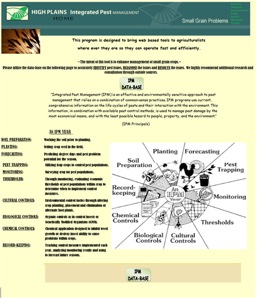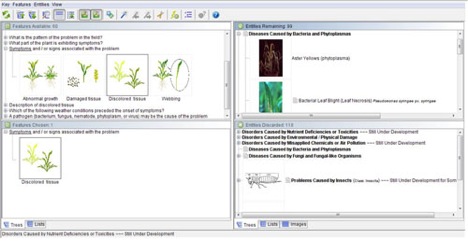 |
December 2010
|
December 2010 // Volume 48 // Number 6 // Ideas at Work // v48-6iw2
Electronic Integrated Pest Management Program: An Educational Resource for Extension and Agricultural Producers
Abstract
As agricultural operations expand and diversify, there is increasing demand for education on pest management tools that can expedite decision-making and improve production practices. The Electronic Integrated Pest Management Program (EIPMP) provides an innovative idea for an up-to-date pest management information database contained on a compact disc (CD) useful for Extension practitioners and agricultural producers in any location. The EIPMP CD innovation is a key beginning to consolidating the vast amount of IPM information that currently exists into a user-friendly format and can be used as a foundation for further expansion.
Introduction
Integrated Pest Management (IPM) focuses on long-term environmentally sound strategies designed to target and prevent pests, reduce pesticides, and use least toxic management practices for control (Miller, 2004). As agricultural operations expand and diversify, there is increasing demand for education on pest management tools that can expedite decision-making and improve production practices (Malone, 2004; Thomas & Gillett, 2008). Educational posters, a multidisciplinary IPM guide for growers, and personal contacts are three methods that have been successful to inform producers (Casella, Nitzsche, Ingerson-Mahar, & Holmstrom, 2003; Thomas & Gillett, 2008; Thomas & Daniels, 2008).
Research by Tackie et al. (2009) found that many limited resource farmers were relatively unfamiliar with IPM practices; therefore, the development of continuing IPM educational programs and materials was recommended. The Electronic Integrated Pest Management Program (EIPMP) provides an innovative, up-to-date pest management information database contained on a compact disc (CD) useful for Extension practitioners and agricultural producers in any location. Currently, there are Internet databases available that provide resources and pest identification tools; however, many producers cannot access the Internet while out in the field. The EIPMP CD format of information was designed to bring the Web-based tools to agriculturalists in any setting to increase efficiency in pest management.
How It Works
The goal of EIPMP is to promote efficient and immediate use of pest management practices in the field. The CD was assembled using data from an existing Internet database that provides producers with research information (Lanier, 2008). The CD contains comprehensive IPM information that can be accessed at remote production sites. This saves producers time and money in lieu of calling Extension agents and specialists. Additional advantages of the CD are that it does not require Internet connectivity, the database is easy to navigate, and it involves minimal learning for the user.
The information and authorization for the initial EIPMP CD was obtained from the High Plains Integrated Pest Management database in the Small Grains Index (Lanier, 2008). The CD was designed to provide the user with assessment tools and recommendations for specific pest management techniques (Figure 1). The structure of the database categorizes selection (Figure 2) and contains a dichotomous key that is internally linked to professional databases based on user choices (Figure 3). The key provides questions that pertain to characteristics being observed in the cultivar. As the user answers questions, the key narrows the field of options until a diagnosis is reached and pest management options are provided. Through this process, EIPMP could be used as a stand-alone management tool that promotes efficient decision-making for all agricultural professionals.
Figure 1
Example Homepage on EIPMP CD

Figure 2
Database Structure on EIPMP CD

Figure 3
EIPMP Dichotomous Key

EIPMP is intended to assist producers, Extension agents, and agribusiness operations in managing cultivars and IPM practices. The software could be designed to track historical pest issues on the operation, help monitor economic thresholds, and manage the IPM practices being implemented to provide a holistic picture of the operation's pest status. Because IPM principals are numerous and vary depending on the cultivar, it is difficult for Extension practitioners to provide workshops for all types of cultivars and all levels of IPM practices. The EIPMP CD can be used as a supplemental resource available through Extension to provide immediate support for producers facing pest management problems.
Results to Date
Currently, the small grains version of the EIPMP CD is available for purchase through Montana State University for a nominal fee. The fee includes production costs, a mailer, a "quick start" set of instructions that highlights features of the disc, and shipping.
The idea for this tool is presented to serve as a foundation for further development in other areas that are tailored to fit the needs of local Extension clientele. Depending upon geographic location, environmental setting, and pest management issues, the CD can be designed to contain IPM information on the most prevalent cultivars seen by producers.
Future Advice/Implications
The program is a key beginning to consolidate the vast amount of IPM information that currently exists into a user-friendly format. Through the efforts of Extension, the program has unlimited potential to become an extremely powerful resource that could advance pest management prevention practices. The CD serves as a quick and practical guide to help producers make better decisions at home or in the field. As agricultural operations grow and diversify, time is always in high demand. This resource can help producers become more efficient due to immediate access to information. With additional time to manage crops, producers have the opportunity to improve profits and identify economic issues early. Extension agents can also use the resource as a quick reference for producers inquiring about pest management issues.
The initial CD only encompasses one set of cultivars—small grains. It would be advantageous to deploy multiple dichotomous keys onto a CD to encompass a variety of cultivars. There are many resources available for expansion into multiple crop systems. With information on additional pests, crops, and management practices, solutions could be compiled to create a more comprehensive program. This innovation can be used as a foundation for further expansion. It is a useful tool that can place professional grade evaluation resources in the hands of every agricultural or extension professional.
Conclusions/Recommendations
The idea behind this electronic resource was to bring information and professional IPM consultation directly to the producer. The program needs continued development in the areas of tutorials, IPM principals, assessment techniques, and tracking software. Tutorials on the content and uses of the information can help educate users. Having knowledge of the software can empower producers to gain professional knowledge at a fraction of the time and cost associated with an extension workshop.
However, to have a successful program CD, long-term support is also needed. The database requires updates and funding for improvements, possibly gained from the revenue raised on the sale of the CDs. Another option is to have the program maintained by Extension specialists who work with IPM issues daily and are searching for new pest management technologies. The EIPMP initiative could usher in a new era of IPM practices in the U.S. agricultural industry.
References
Casella, M., Nitzsche, P., Ingerson-Mahar, J., & Holmstrom, K. (2003). Integrated pest management poster for farm markets. Journal of Extension [On-line], 41(1) Article 1TOT5. Available at: http://www.joe.org/joe/2003february/tt5.php
Lanier, W. (2008). High plains integrated pest management. Small grains index. Retrieved February 1, 2010, from: http://wiki.bugwood.org/HPIPM:Small_Grains
Malone, S., Herbert, D. A., & Pheasant, S. (2004). Determining adoption of integrated pest management practices by grains farmers in Virginia. Journal of Extension [On-line], 42(4) Article 4RIB6. Available at: http://www.joe.org/joe/2004august/rb6.php
Miller, D. (2004). A training program for cooperative extension agents: Implementation of integrated pest management (IPM) in Virginia public schools. Journal of Extension [On-Line], 42(5) Article 5FEA3. Available at: http://www.joe.org/joe/2004october/a3.php
Tackie, N., Jackai, L., Ankumah, R., Dingha, B., Salifu, A., & Ojumu, O. (2009). Integrated pest management and protection practices by limited resource farmers. Journal of Extension [On-line], 47(1) Article 1RIB6. Available at: http://www.joe.org/joe/2009february/rb6.php
Thomas, J., & Daniels, C. (2008). Comment coordinators: Connecting stakeholders and regulatory agencies. Journal of Extension [On-line], 46(1) Article 1IAW7. Available at:http://www.joe.org/joe/2008february/iw7.php
Thomas, D., & Gillett, J. (2008). How to make a multidisciplinary IPM guide for growers using Adobe Pagemaker templates. Journal of Extension [On-line], 26(6) Article 6TOT6. Available at: http://www.joe.org/joe/2008december/tt6.php




